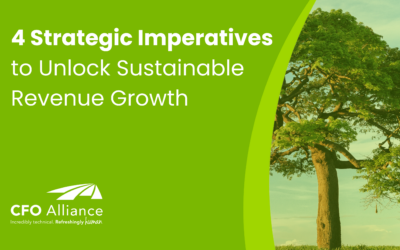How To Design Your Corporate Budget Strategy for Competitive Advantage
On the other hand, maybe you’re thinking: “Budget season? Already? Isn’t it a little early?”
Absolutely not. Of course, you could probably get by with hammering out your budget in two weeks in December, but effective budgets – the kind that position you for growth and competitive advantage – take time. If you want your budget to be a powerful tool that moves your business forward, you need time to ideate, tease out what is meaningful, and create a strategic plan that puts you in a strong financial position. And the more decision makers you have contributing to the process, the longer it will take.
Here’s what you need to know to get started.
Assess Your Current Financial State
Get Cozy with Your Data
Spend some time working through financial metrics and evaluating your balance sheet, cash flow strategy, and other key indicators of financial performance. The most successful companies are data-driven, with reliable systems and processes to capture and measure data efficiently. (If you’re not there yet, this should be an investment area for next year!)
Conduct a SWOT Analysis
A SWOT analysis takes a strategic, in-depth look at Strengths, Weaknesses, Opportunities, and Threats. This will show you what you’re doing well, where you need to invest, how you can take advantage of opportunities, and what you can do to minimize risks. It will also help you analyze where you have competitive advantage over competitors and where you need to make changes.
Study Your Market
Research your closest competitors and evaluate who is succeeding and who isn’t within the market. Ask questions like these:
- What are competitors doing differently from others in the industry? Is it working for them?
- How can we learn from what competitors are doing well?
- How can we outperform them in that area?
- What new trends are happening in your market?
- Who is the strongest competitor. What are they doing that you are not?
- What is your business going to do differently to outperform your competition and stand out in the market?
- What market conditions are changing that could impact your business positively, negatively, or both?
Evaluate Challenges and Risks
Dig a little deeper into the weaknesses and threats you identified in your SWOT analysis to determine where you need to invest in the coming year.
- What external and internal roadblocks do we need to address?
- How have economic conditions impacted revenue or customer retention?
- Are we facing any talent or supply chain shortages?
- What about technology or infrastructure?
All these things will help you determine where you need to adjust your budget as you plan your goals for 2023.
Identify High-Level Strategic Budget Goals for Next Year
How will you outperform competitors by creating competitive advantage?
Once you have these goals in mind, your budget will show you how to execute and where to invest. For example, if you have a $10 million revenue goal, you’ll need to refine that goal by asking follow-up question like these:
- Which line(s) of business will be the biggest growth drivers?
- How many new deals will that take? How many deals can my team close per year?
- Can we get to our goal with organic growth or do we need to acquire?
- What do you need to make that growth happen?
- Do you need additional talent to reach your goal? In which functions and departments?
- Do you need to refine any of your current operational or financial processes? Where will growth break something?
- Where can you invest to improve efficiency and productivity?
Make a Plan to Get There
Here are some additional questions to ask as you build out your plan:
What is my financial strategy?
- Are my revenue models staying the same?
- What is my go-to-market strategy?
- How can I get competitive with pricing?
- How can I retain clients longer?
- Does my business model need to change?
What is my talent strategy?
- Where do I need to invest in new talent?
- What new team members do I need to accomplish my goals for next year?
- Which roles should be filled internally, and which ones can I outsource?
What is my tech strategy?
- Do I need to upgrade my technology to support growth?
- Do I need to invest in an ERP?
- If so, what support do I need for a technology implementation?
- How can I automate for greater efficiency and productivity?
What is my operational strategy?
- What areas of the business do I need to invest in (outbound recruiting, HR, sales strategy, customer retention, etc.)?
- What parts of the company are incomplete and should be built out internally or outsourced?
What other areas do I need to invest in?
- Am I planning a merger or acquisition?
- Do I need to update systems and processes?
- Do I need to bring in new leadership or departmental talent?
Top Takeaway: Start Now
If you need help, we’re here! Budgeting is our jam, so don’t hesitate to reach out for additional support as you create your budget and put the right tools in place to execute in the new year. Contact us to start the conversation!
.
.
4 Strategic Imperatives to Unlock Sustainable Revenue Growth
4 Strategic Imperatives to Unlock Sustainable Revenue GrowthCreating long-term, sustainable revenue growth takes more...
Future-Proof Your Workforce with a Modern Talent Agenda
Future-Proof Your Workforce with a Modern Talent AgendaWhat does the future of talent look like? It’s a fair question,...
The Talent Behind the Tech: How Skills-Based Hiring Supports Technology Innovation
The Talent Behind the Tech: How Skills-Based Hiring Supports Technology InnovationStaying relevant with technology in...




